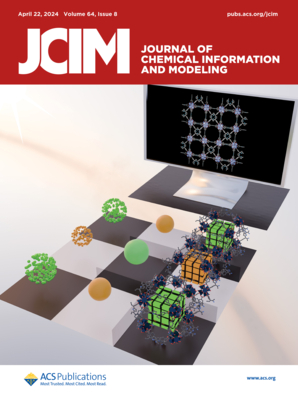A Computationally Efficient Method to Generate Plausible Conformers for Ensemble Docking and Binding Free Energy Calculations.
IF 5.3
2区 化学
Q1 CHEMISTRY, MEDICINAL
引用次数: 0
Abstract
This study presents a computationally efficient approach to generate plausible protein conformers for ensemble docking to enable evaluations of interactions between ligand and protein for ranking the docked ligands according to their binding affinities. Two binding regions of triose phosphate isomerase (TIM), its catalytic site with DHAP (G. gallus TIM), and its dimer interface with 3PG (P. falciparumTIM) involving flexible loops were investigated as case studies. The binding sites of the apo and holo forms were modeled at the atomistic scale (high resolution) while the remaining structure was coarse-grained (low resolution) leading to a mixed-resolution description of the protein. The slowest three normal modes related to the functional dynamics of TIM were obtained using the Anisotropic Network Model and employed to derive 36 conformers of the truncated high-resolution regions by assessing six deformation parameters in both directions of the harmonic motions. Through energy minimization and docking calculations in Glide, optimal extents of deformation were identified. The docked truncated structures were then subjected to independent molecular dynamics (MD) simulations to confirm the interactions of the ligands in the binding sites. To prevent the disintegration of the truncated structure, different buffer zones and harmonic restraints were assessed to finally decide on four distinct zones with restraints of 0, 25, 35, and 50 kcal/mol·Å2. Each conformer underwent 900 ns-long simulations across three replicates reaching a total simulation time of 15.2 μs. Binding free energy calculations were conducted using the MM-GBSA approach using the first 50, first 100, first 200, and 300 ns intervals, which pointed out that 100 ns-long simulations were sufficient to estimate the binding affinities for TIM. Results consistently indicated comparable binding energies between the intact and truncated TIM structures underscoring the approach's reliability, where the truncated conformers also offered varying binding site geometries yielding favorable interactions. Comparative docking at the dimer interface of G. gallus and P. falciparum TIM further highlighted species-specific binding dynamics, affirming the methodology's applicability for diverse biological questions and establishing a computationally efficient approach to estimate binding free energy values even for supramolecular assemblages.为系综对接和束缚自由能计算生成合理构象的高效计算方法。
本研究提出了一种计算效率高的方法来生成合理的蛋白质构象,用于整体对接,从而能够评估配体和蛋白质之间的相互作用,并根据它们的结合亲和力对对接的配体进行排序。本文研究了磷酸三糖异构酶(TIM)的两个结合区、与DHAP的催化位点(G. gallus TIM)以及与3PG (P. falciparumTIM)涉及柔性环的二聚体界面。载脂蛋白和全息形式的结合位点在原子尺度上(高分辨率)建模,而剩余的结构是粗粒度的(低分辨率),导致蛋白质的混合分辨率描述。利用各向异性网络模型获得了与TIM功能动力学相关的最慢的3个正态模态,并通过评估谐波运动两个方向的6个变形参数,推导出截断的高分辨率区域的36个构象。通过滑翔过程中的能量最小化和对接计算,确定了最优变形量。然后对停靠的截短结构进行独立分子动力学(MD)模拟,以确认结合位点上配体的相互作用。为了防止截断结构的解体,对不同的缓冲带和谐波约束进行了评估,最终确定了4个不同的缓冲带,分别为0、25、35和50 kcal/mol·Å2。每个构象体经过3次重复900 ns的模拟,总模拟时间为15.2 μs。利用MM-GBSA方法计算了前50、前100、前200和300 ns的结合自由能,指出100 ns长的模拟足以估计TIM的结合亲和力。结果一致表明,完整的和截断的TIM结构之间的结合能相当,强调了该方法的可靠性,其中截断的构象也提供了不同的结合位点几何形状,产生有利的相互作用。在鸡和恶性疟原虫二聚体界面的对比对接进一步突出了物种特异性结合动力学,肯定了该方法对多种生物学问题的适用性,并建立了一种计算效率高的方法来估计结合自由能值,即使是超分子组装。
本文章由计算机程序翻译,如有差异,请以英文原文为准。
求助全文
约1分钟内获得全文
求助全文
来源期刊
CiteScore
9.80
自引率
10.70%
发文量
529
审稿时长
1.4 months
期刊介绍:
The Journal of Chemical Information and Modeling publishes papers reporting new methodology and/or important applications in the fields of chemical informatics and molecular modeling. Specific topics include the representation and computer-based searching of chemical databases, molecular modeling, computer-aided molecular design of new materials, catalysts, or ligands, development of new computational methods or efficient algorithms for chemical software, and biopharmaceutical chemistry including analyses of biological activity and other issues related to drug discovery.
Astute chemists, computer scientists, and information specialists look to this monthly’s insightful research studies, programming innovations, and software reviews to keep current with advances in this integral, multidisciplinary field.
As a subscriber you’ll stay abreast of database search systems, use of graph theory in chemical problems, substructure search systems, pattern recognition and clustering, analysis of chemical and physical data, molecular modeling, graphics and natural language interfaces, bibliometric and citation analysis, and synthesis design and reactions databases.

 求助内容:
求助内容: 应助结果提醒方式:
应助结果提醒方式:


